Just how Many Things Does the Term “Keyboard Layout” Refer to?
Just how many things does the term “keyboard layout” refer to? Oh, plenty! To make matters
worse, those meanings are layered and interrelated. This page distinguishes and describes each of them.
The term “keyboard layout” can refer to: a keyboard’s form
factor, its physical layout or its logical (or national)
layout.
The form factor of a keyboard is its general
shape and the grouping of the keys it contains in key blocks. Arrangement variations within
a block are a matter of the physical layout.
There are many different form factors, and the most common ones are generally known by a name.
Form factors can be grouped into non-compacts (those where the base form factor is composed of
several key blocks), compacts (those where the base form factor is composed of a single
block, equivalent to the main one in a non-compact; variants with small separated key clusters, that clearly have
been derived from the base form factor, are also counted) and terminals (those that were
typically present on computer terminals; they are counted separately from non-compacts for historical
reasons). The following diagram shows several of them:
Full-size.
IBM released the Enhanced Keyboard in 1985 (not 1986; see below); it
was such a massive success that it wiped the floor out of everything else, including IBM’s own older stuff, and
became the standard in computer keyboards, to the point that the Enhanced
Layout form factor it used later became known simply as full-size,
because for all practical purposes: a) it has always been here; b) most of the form factors created
afterwards have been designed as variations of it (amost always reductions in size).
While it’s true that Enhanced Keyboards for general-purpose personal computers were
released in April 1986 (P/N 1390131 replaced AT layout keyboards, while P/N 1390120 replaced
XT layout keyboards), the first Enhanced Keyboards for use in terminals were released in
June 1985 (P/Ns 1386303 and 1386304, part of the IBM 3161 terminal); even earlier, May 1985 saw the release of the
IBM 7531 Industrial PC (itself a modified version of an IBM PC AT), which came with what we now call an
“Industrial Model M” keyboard (P/N 1388032).
A typical full-size keyboard has a main block (15×5U in size), with
a key row above it (divided in four groups), a 13-key cluster to its right (subdivided in three groups), and a
4×5U key block to its further right.
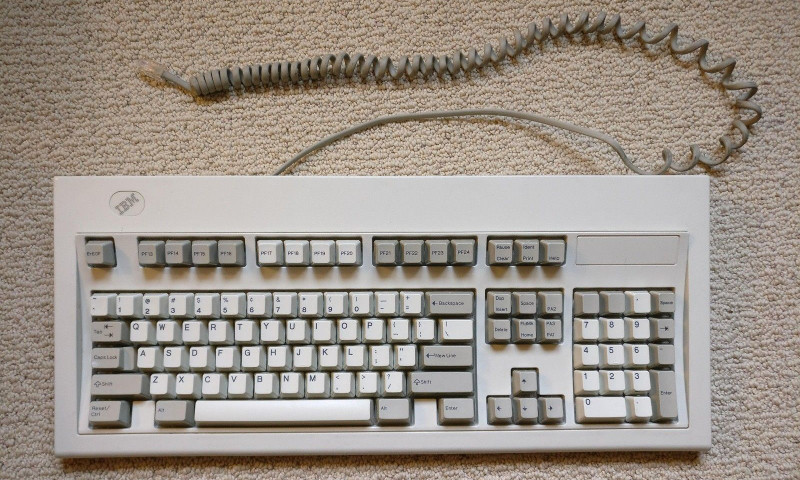
IBM Model M keyboard; form factor: full-size.
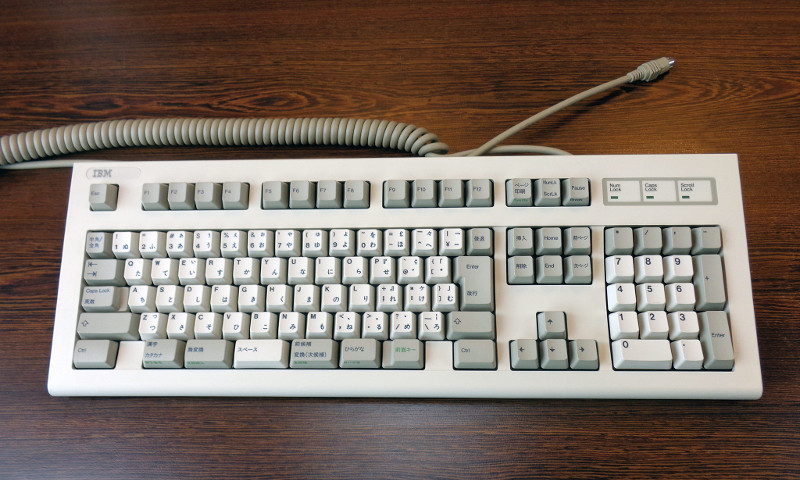
IBM 5576-002 keyboard; form factor: full-size.
Tenkeyless.
The tenkeyless, TKL or
80% form factor is the same as the full-size, but
without the rightmost 4×5U key block. It was invented by IBM as well, and introduced with the Model M Space
Saving Keyboard (“SSK”) in 1986 (the names “tenkeyless” and
“80%” are much younger, though; furthermore, the former comes from the also recent moniker
“tenkey” for the numeric keypad).
A typical tenkeyless keyboard has a main block (15×5U in size), with
a key row above it (divided in four groups), and a 13-key cluster to its right (subdivided in three groups).
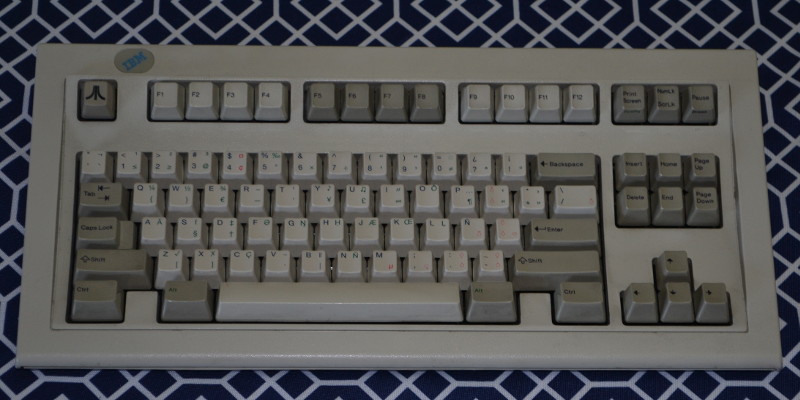
IBM Model M SSK keyboard; form factor: tenkeyless.
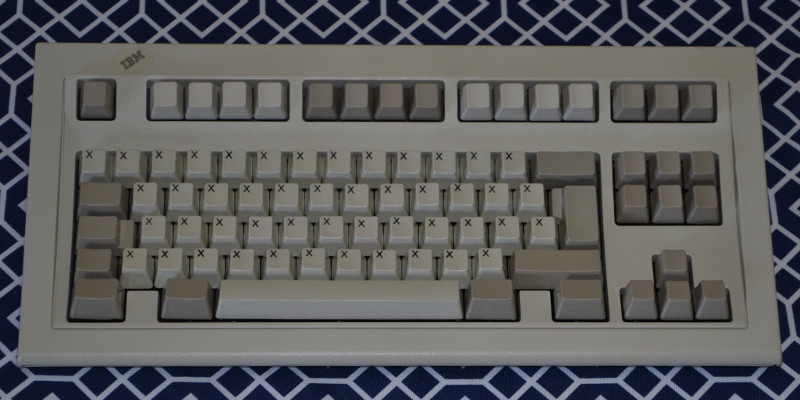
IBM Model M SSK keyboard; form factor: tenkeyless.
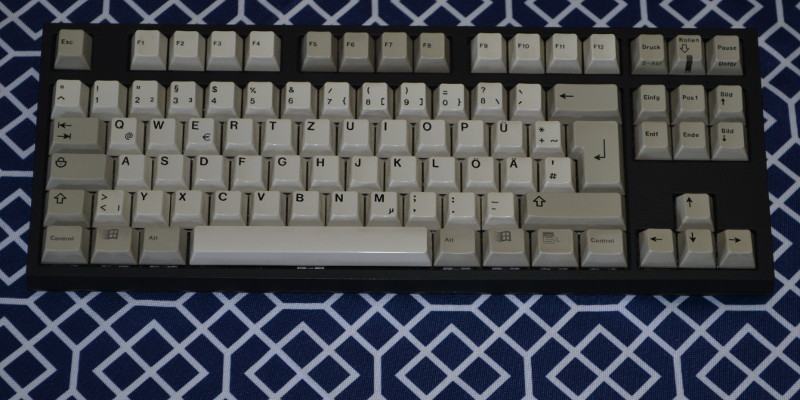
WASD v2 keyboard; form factor: tenkeyless.
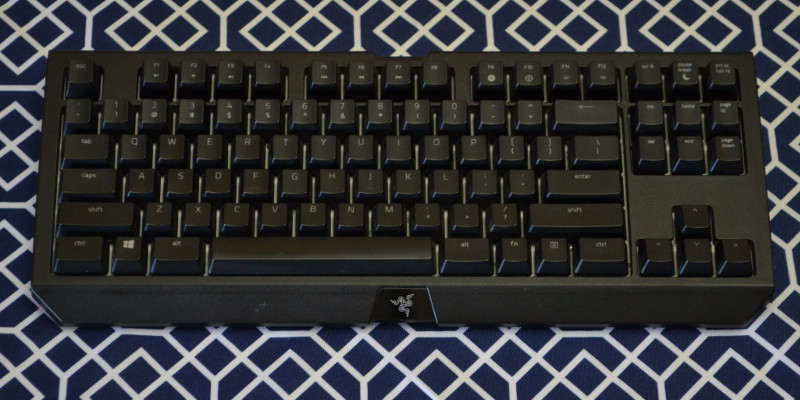
Razer Blackwidow keyboard; form factor: tenkeyless.
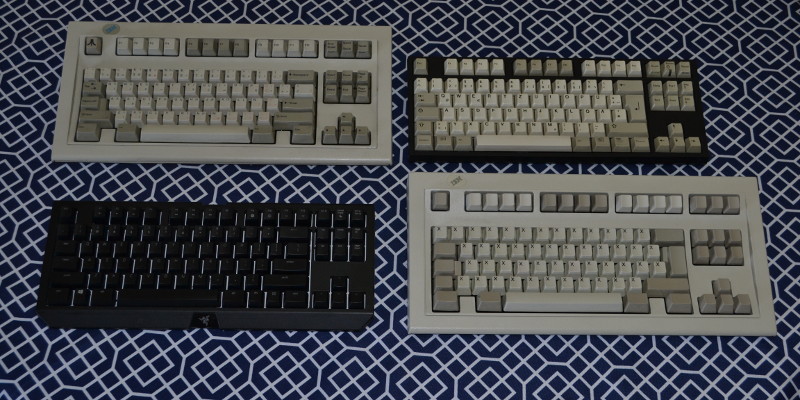
Four keyboards, one form factor.
1800.
The 1800 form factor takes its name from the 1800 models in Cherry’s
G80 and G81 lines of keyboards that (very probably introduced and) popularized it. This was probably the first
variation of the full-size form factor aimed at diminishing the keyboard’s size without
reducing its total amount of keys. To this effect, the rightmost clusters are (mostly) squished together into a
single 4×7U key block, with the inverted T subcluster sandwiched between it and the main block to the
left.
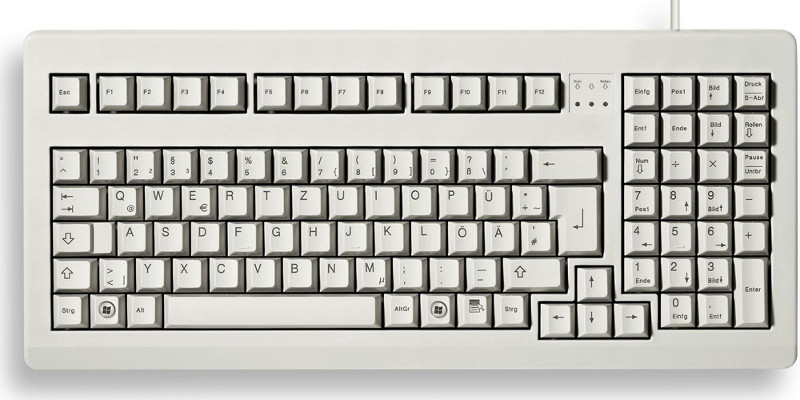
Cherry G80-1800 keyboard; form factor: 1800.
1800-like.
The 1800-like form factor is a further reduction on the
1800 form factor. The separation between the top row and the main block is reduced from 1U to
0.5U or even 0.25U (this is a common change in modern full-size keyboards as well), and the
rightside keypad is reduced to a top row of four keys and a 4×5U keypad.
This form factor is often called 96-key, after its (approximate) key
count, but this clashes with the 96% form factor, which also gets called that. It doesn’t
help that both form factors have notorious similarities that become even more striking once the typical assignments
for the respective logical layouts are taken into account.
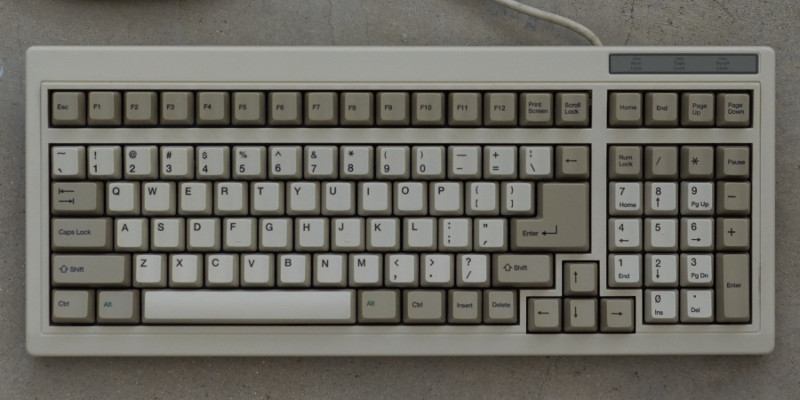
Unikey KB-6551 keyboard; form factor: 1800-like.
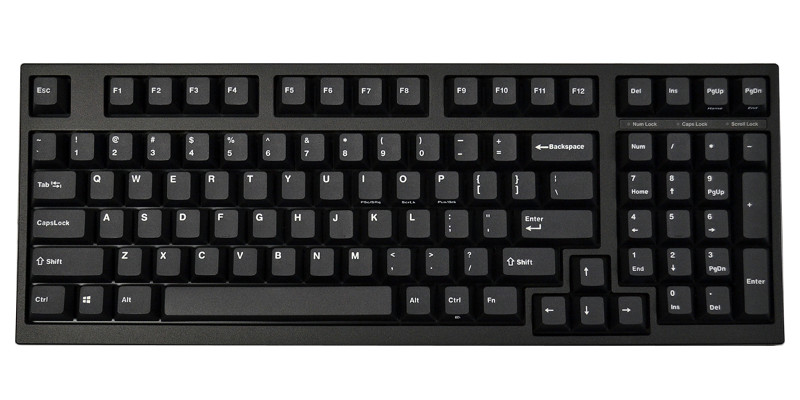
Leopold FC980M keyboard; form factor: 1800-like.
XT layout.
The very first IBM Personal Computer (the IBM 5150) was introduced in August 1981 and had what at the time was
quite an innovation: a keyboard that was not an integral part of the computer, but had to be plugged to it with a
cable!
The PC keyboard sported what we now call the XT layout...
which is a serious misnomer, as “XT” actually refers to the IBM PC XT (IBM 5160), introduced in March
1983, which also used this keyboard. But even calling it “OG PC” or “5150 layout” would be
wrong, because the form factor was taken from an earlier computer, the IBM System/23 Datamaster, released in July
1981 (this computer came in two varieties: the less uncommon “desktop” 5322
model, which had an integrated keyboard, and the rather uncommon “floor” [“tower”, in modern
parlance] 5324 model, with an external keyboard)... and even then, the “Datamaster layout” was an
obvious derivation from the IBM 5251 terminal keyboard’s layout. Strictly speaking, the
XT layout ought to be called 5251′
layout, but it would take several miracles to get this name to stick. XT
layout it is, then.
The IBM Personal Computer was a massive success, but its keyboard... was the target of a lot of criticism, as its
layout was very strange, even for the time, and had obvious defects, the abuse of stepped keys being the worst one.
IBM retired this form factor when it introduced the better designed AT layout.
A keyboard with the XT layout has a main block (18.75×5U in size,
not 19×5U), with a 2-column keyblock to its left.
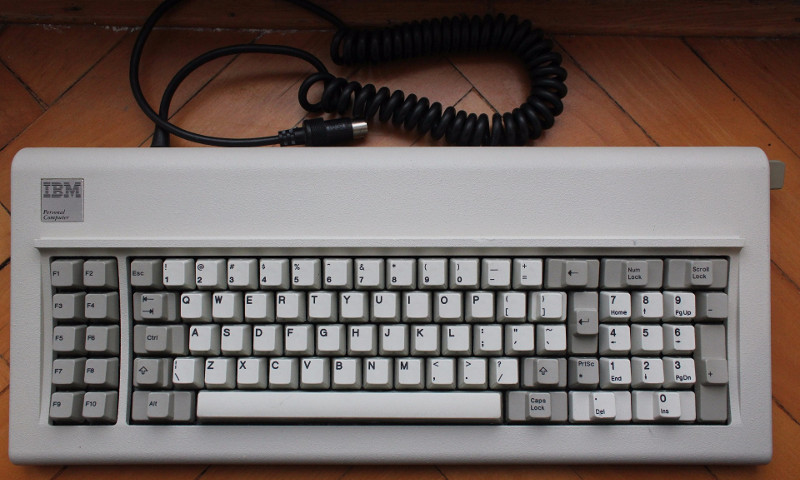
IBM Model F XT keyboard; form factor: XT layout.
AT layout.
The AT layout form factor was introduced with the IBM PC AT (IBM 5170) in
August 1984 and replaced the earlier XT layout; the AT
layout had several significant improvements over its predecessor, and an undeniably better form factor... but
it was tarnished by the abomination we today call BAE. After
further research and development, IBM replaced this form factor in 1986, when it introduced the Enhanced
Keyboard, sporting the Enhanced Layout, for their differing lines of general-purpose
personal computers.
A keyboard with the AT layout has a main block (15×5U in size), with
a 2-column keyblock to its left and a 4×5U key block to its further right.
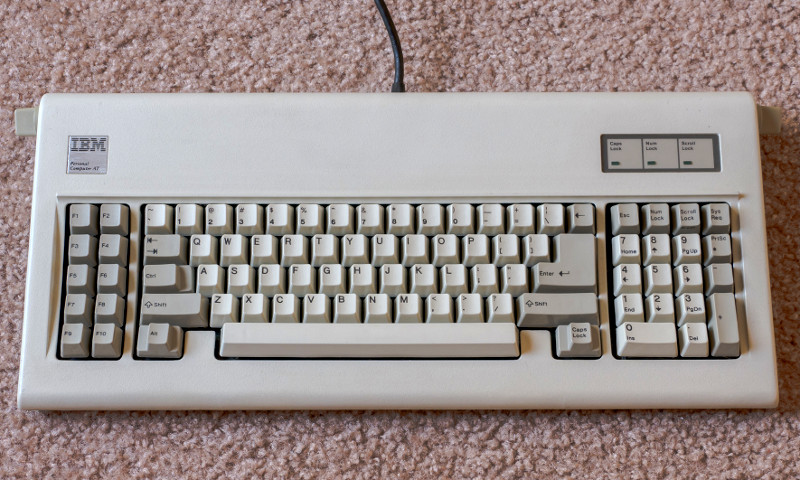
IBM Model F AT keyboard; form factor: AT layout.
96%.
The 96% layout form factor was created by taking a
75% and adding three columns to its right side. Given it exceeds the size of a
tenkeyless, it’s considered a non-compact compact (yeah).
This form factor is often called 96-key, after its (approximate) key
count, but this clashes with the 1800-like form factor, which also gets called that. It
doesn’t help that both form factors have notorious similarities that become even more striking once the typical
assignments for the respective logical layouts are taken into account.
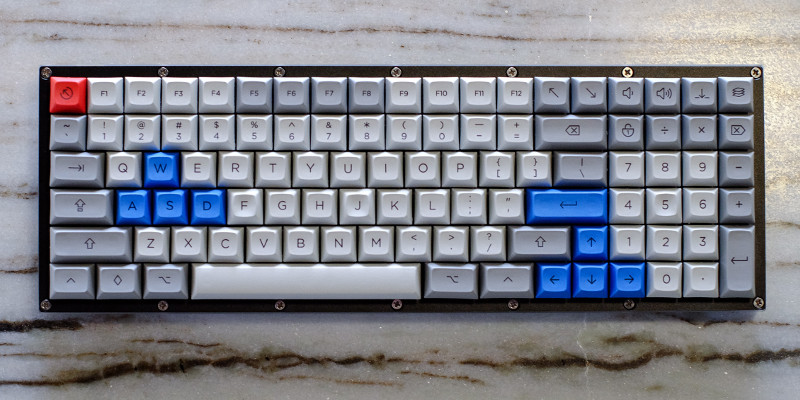
YMD96 keyboard; form factor: 96%.
60%
The 60% form factor contains a single 15×5U key block. This is the
quintessential compact, and was created by taking the full-size’s main block and
discarding everything else. Its name comes from the fact that its key count is about... get ready for
this... sixty percent of the keycount of a full-size.
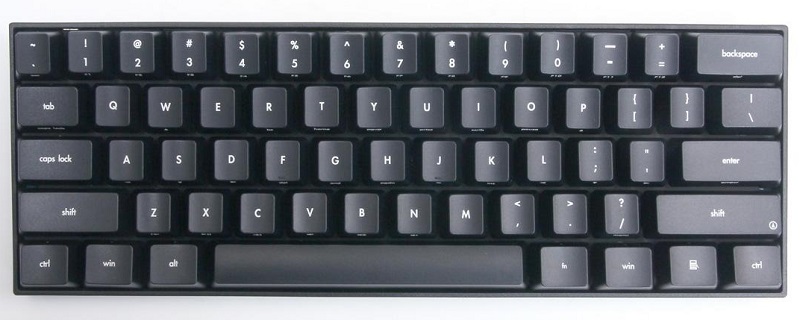
KBP V60 keyboard; form factor: 60%.
The 60% form factor has been present since pretty much the early days of
computing, although its categorization as “compact” is a recent phenomenon (back in
the day, they just were what they were). To wit:
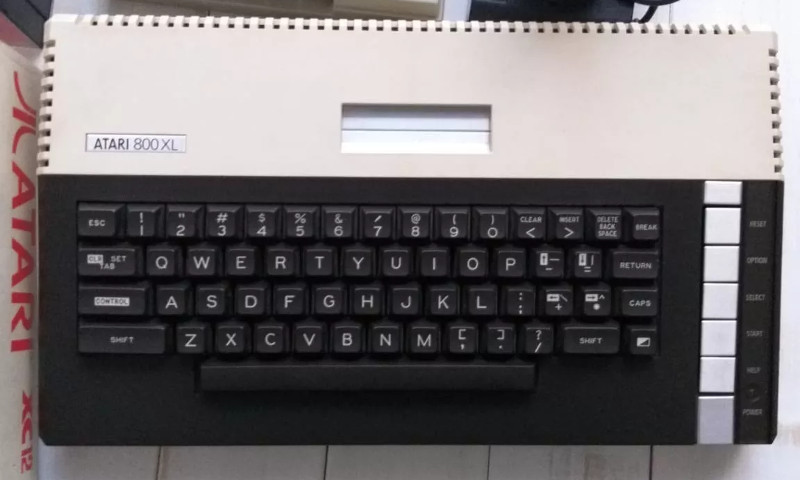
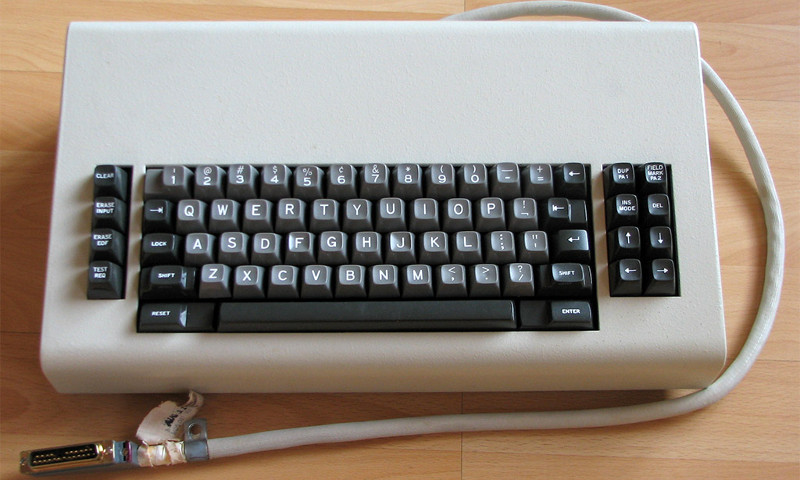
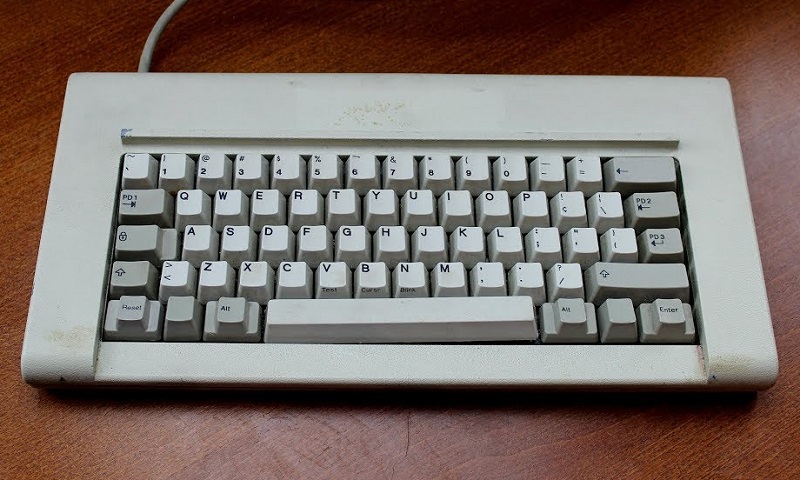
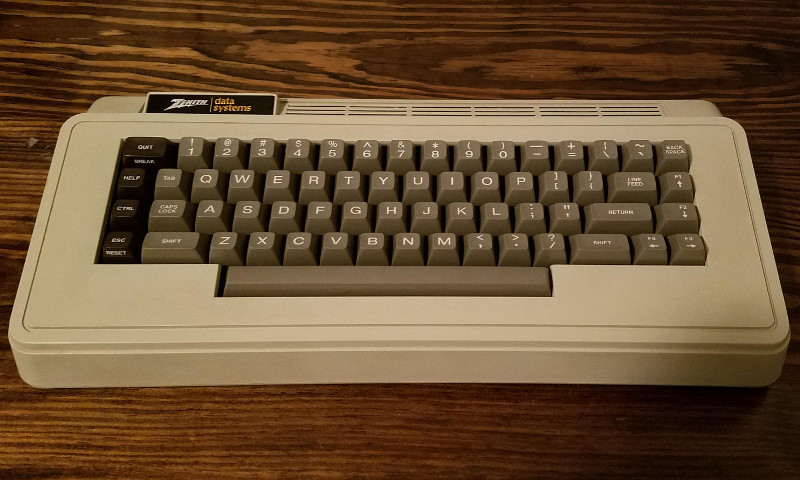
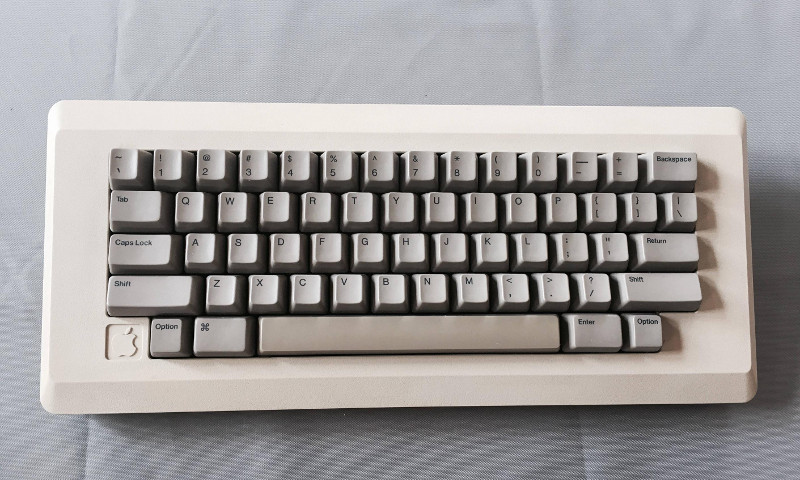
Yeah.
660.
The 660 layout form factor looks like a common 60%,
with an “outgrowth” in its bottom right and an “island” of two extra keys on the top
right.
This form factor’s name comes from the Leopold FC660 line of keyboards; this form factor was actually
invented by this company and is modestly popular on the custom keyboard community as well.
Some sources erroneously refer to this form factor as “65%”; the actual 65% is a
bit larger.
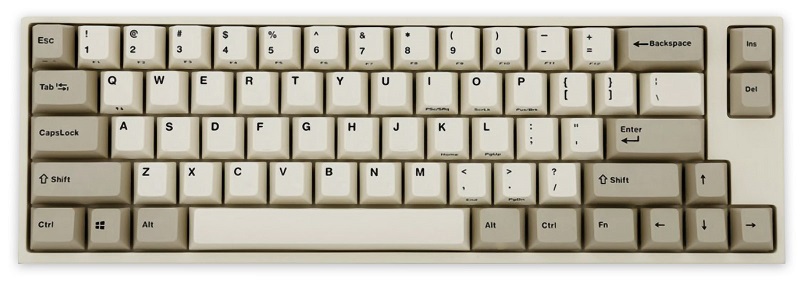
Leopold FC660M keyboard; form factor: 660.
65%
The 65% form factor contains a single 16×5U key block. It was
created, as its name implies, by taking a 60% and adding a column to its right side.
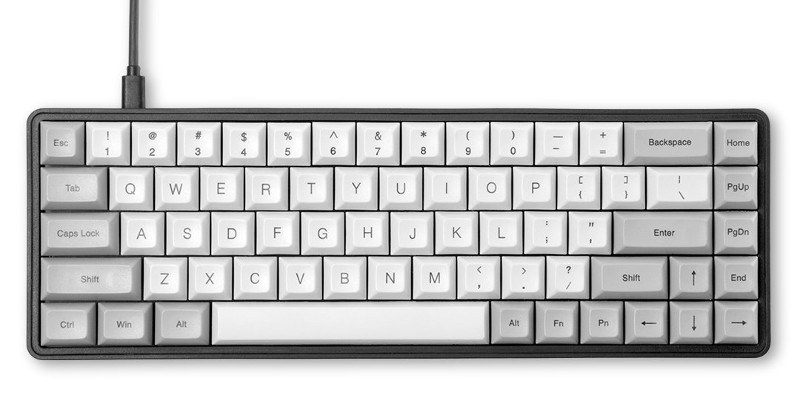
Vortex Cypher keyboard; form factor: 65%.
75%
The 75% form factor contains a single 16×6U key block. It was
created by taking a 60% and adding a column to its right side plus a row to its top side.
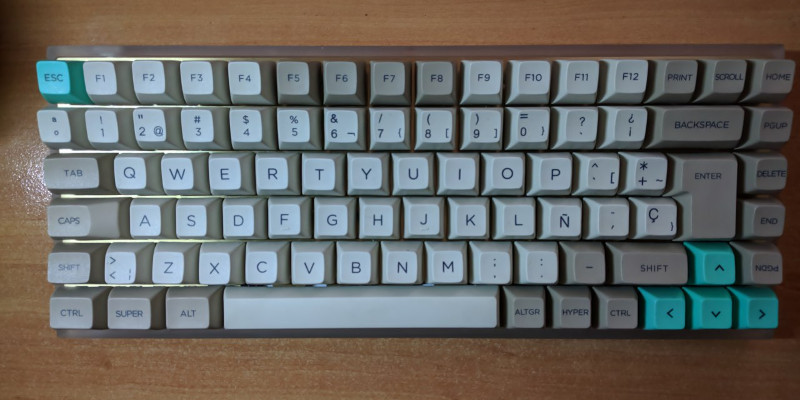
YMD75 custom keyboard; form factor: 75%.
“Exploded” variations, where the top row is separated from the rest by 0.25U, and/or the rightmost
keys (which will be the cursor and navigation keys) are separated as well, are gaining
popularity and are generally considered to be part of the 75% form
factor.
79%
The 79% form factor contains a single 17×6U key block. It was
created by taking a 75% and adding a column to either its right or its left side. This
relatively uncommon form factor gets its pattern-breaking name due to “80%” having already been taken to
refer to the tenkeyless form factor.
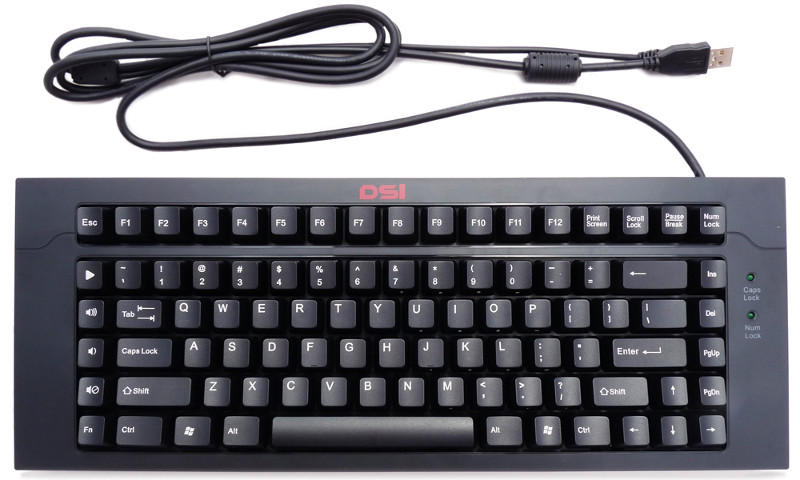
DSI-90 keyboard; form factor: 79% (extra column on the left-side; separated top row variant).
It’s generally agreed that compact form factors must be smaller than a tenkeyless;
therefore, this is the largest one, while the largest commonly used form factor is the
75%.
40%
The 40% form factor contains a single 12×4U
(sometimes 12.5×4U or even 13×4U) key block. Depending on the point of view,
this is either the smallest compact or the largest ultra-compact form factor.
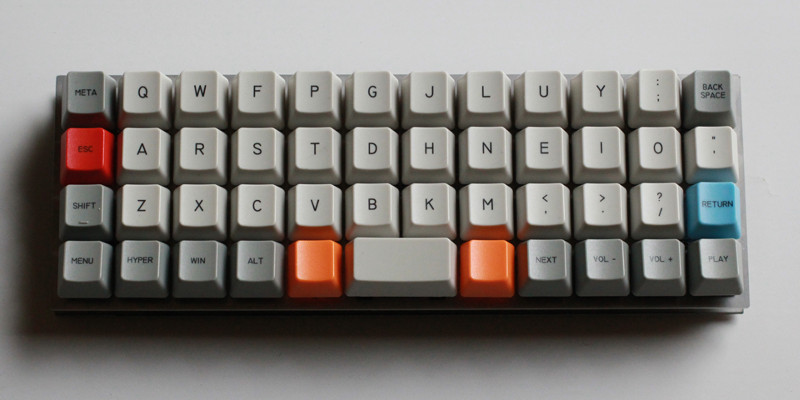
Planck keyboard; form factor: 40%.
Battleship.
IBM’s terminal keyboards of the ’80s and ’90s were pretty large. They recently got
nicknamed “battleships” because of their size, and that name has stuck both for the keyboards themselves
and for their form factor; IBM’s actual name for these keyboards (and the unsavers) is
“Converged Keyboard”.
A further modern refinement on the “battleship” term, as used for the keyboards themselves, is the
distinction between it and “battlecruiser”: the former word is applied to the IBM F122 and early IBM M122
keyboards, and the very few third-party units that exceed them in size; the latter is used for the later M122
keyboards (which are a bit smaller thanks to reductions in bezel size) and most of the third-party units. The form
factor, however, is always called battleship.
A keyboard with the battleship or
converged layout (be it an IBM-made unit or a third-party one) has a main
block (15×5U in size), with a 2-row keyblock above it, a 2-column keyblock to its left, an 11-key cluster to
its right, and a 4×5U key block to its further right.
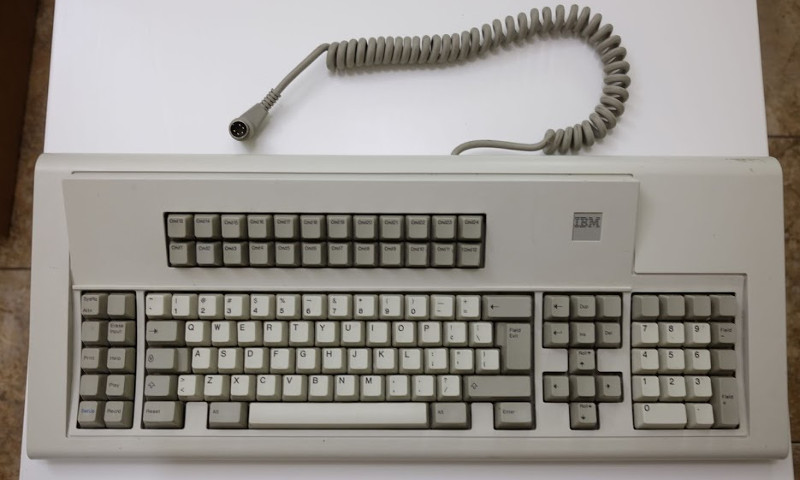
IBM Model M122 keyboard; form factor: battleship.
Unsaver.
The unsaver was a relatively uncommon terminal keyboard back in its day... but is highly coveted and sought after
now, for the same reason IBM Model M SSK keyboards are. Its name is another recent jokeful
nickname that stuck, both for the keyboard itself and its form factor: those things should be small, but
their actual width is close to that of a modern full-size keyboard, so they don’t
really save that much space.
An unsaver (or, strictly speaking, a
[numpadless] converged) keyboard has a main block (15×5U in size), with
a 2-row keyblock above it, a 2-column keyblock to its left, and an 11-key cluster to its right.
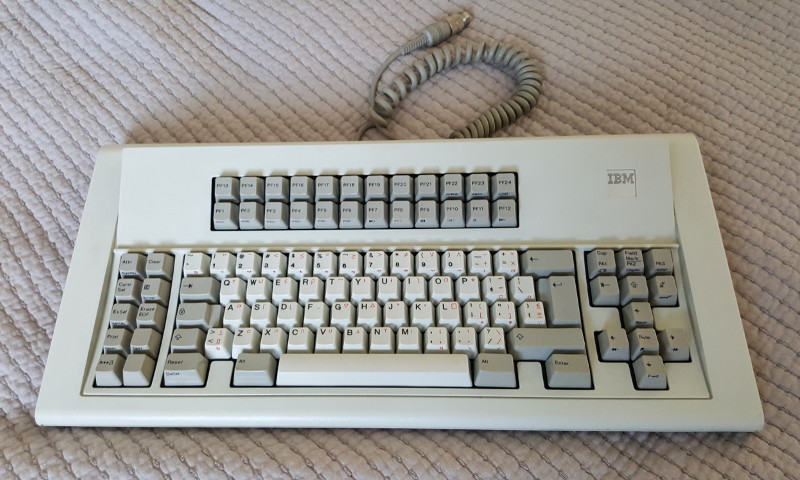
IBM Model F104 keyboard; form factor: unsaver.
DEC layout.
In 1982, DEC released the LK201 keyboard, which was first used with its VT220 computer terminal; the LK201’s
layout contained several improvements over its predecessors, used in the VT50 and VT100 terminal families. For the
next few years, before the late eighties’ second explosion of personal computer sales happened (carrying the
Enhanced Layout with it), the large majority of all extant computer keyboards were
terminal keyboards, and most of those were either LK201 keyboards accompanying VT220 or VT320
terminals, or third-party copies, connected to VT220 clones; their ubiquitous presence and their strong
identification with DEC made the name DEC layout (to refer to, strictly
speaking, the LK201 layout) stick, even today.
Although LK201 and LK201-like keyboards are quite rarely seen in production environments today, the influence of
this form factor was long-lasting and continues up to the present — the most notorious one is the
“inverted T” key cluster for the arrow keys, which was introduced in the LK201 keyboard
(earlier, IBM had replaced the block or square cluster in its layouts with the
cross-shaped cluster, which was used up to and including the AT layout; the company
finally switched to the inverted T cluster with the introduction of the Enhanced Layout,
although the battleship and unsaver form factors remained unaltered
in this regard).
A DEC layout keyboard has a main block (15-ish×5U in size),
with a 10-key cluster to its right, a 4×5U key block to its further right, and a key row above all of it.
Note how irregular the borders of the main block are: this used to be the case in keyboards of most makes and
models; it was IBM who succesfully spearheaded the change to strictly rectangular main blocks, which is today’s
standard.
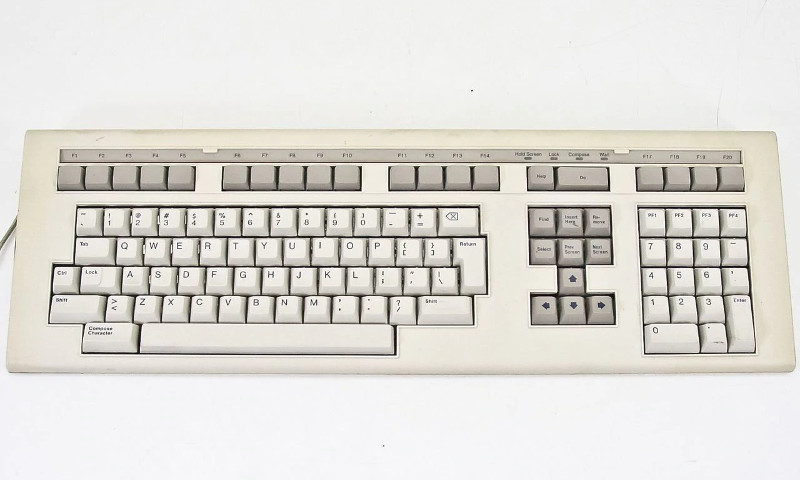
DEC LK201 keyboard; form factor: DEC layout.
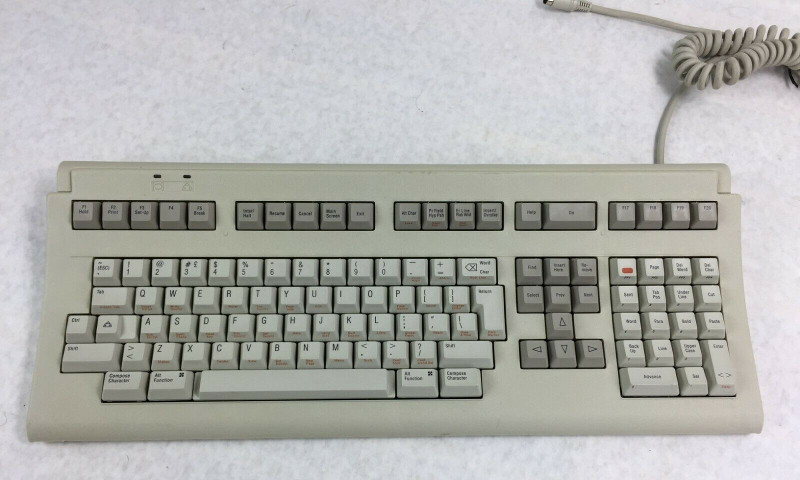
DEC LK411 keyboard; form factor: DEC layout (later variant).
Physical layout.
The physical layout of a keyboard is the specific
arrangement of keys within each key block, for a given form factor.
Evidently, the physical layout is heavily tied to the form factor, to the point where both concepts are used
interchangeably, a source of confusion for some.
Furthermore, there are certain specific common variations in physical layouts that are shared across differing
form factors; those variations have well-known names, too (again, to the point of erroneously conflating form factor
and physical layout).
Staggered rows or matrix (“ortholinear”) arrangement.
In the beginning, there was the typewriter, a complex machine that used all kinds of internal contraptions to
convert the user’s action of pressing a key into a letter being actually typed on paper. Typewriters had their
key rows offset with respect to one another to allow inner mechanisms to work without interfering among themselves.
More than a century later, those physical restrictions are long gone... yet the row staggering remains unchanged and
is an expected component of a normal keyboard, to the point that it’s not even described as a possible variant
of a physical layout.
Despite the above, keyboards with matrix arrangements have gained traction among compact form factors during the
last few years, with larger the presence the smaller the size: relatively rare in 65% and
larger, not uncommon in 60%, common in 40%, ubiquitous in 30%
ultra-compacts.
Units with form factors smaller than 30% are not even counted as “keyboards”, but rather
as keypads, where the matrix arrangement has been the standard since basically forever.
These two keyboards show the striking difference between both arrangements:

Form factor: 60%; physical layout: staggered.
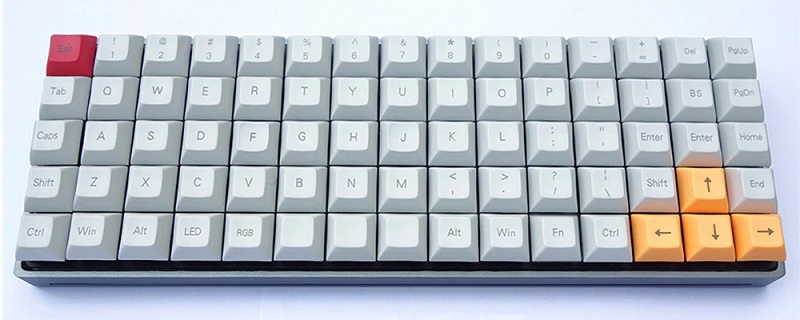
Form factor: 60%; physical layout: ortholinear.
Yes: albeit it may be counterintuitive at first, those two keyboards have the same 60% form
factor, as they are both 15×5U in size.
Japanese stagger.
The common stagger of rows in the main block of a keyboard follows a well-established sequence:
from the top row to the bottom, the keys are offset to the right by 0.5U, 0.25U, 0.5U and 0.25U
(the offset for the bottom row holds for all its common variants).
However, in some keyboards manufactured in Japan, the offset for the fourth row is 0.25U instead of 0.5U;
this is known as the “Japanese stagger”.
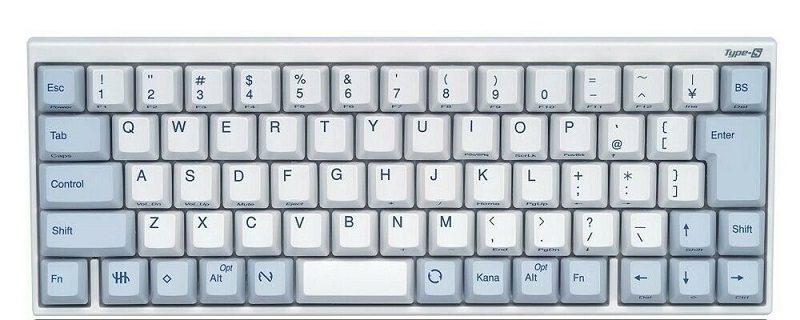
Form factor: 60%; physical layout: Japanese stagger and JIS (see below).
Differing bottom rows.
The bottom row of the main block of a keyboard typically has a really long key (a “bar”, if you will)
and a bunch of other keys to either side. Bottom rows are described by a formula that lists the length of each key
from the left corner to the right one; the most common configurations are known by specific names:
Winkeyless,
WKL or
vintage
(1.5/(1)/1.5 / 7 / 1.5/(1)/1.5): the
bottom row as specified by the Enhanced Layout; the standard bottom row until Microsoft forced its
Windows-specific keys upon the world.
Non-standard
(1.5/1/1.5 / 6 / 1.5/1/1/1.5): the
bottom row as initially directed by Microsoft when it introduced its Windows-specific keys. Both empty spaces
(which had been left empty for a reason, not that Microsoft actually cared) were filled
in, and the bar was shortened to 6U and the third 1.5U key displaced to the left to make room for a third
key.
These three Windows-specific keys were universally hated and reviled, and with good reason;
additionally, it did not help matters that Microsoft (which at this time had most OEM companies grabbed by the...
uuuuuh... bells) actually allowed small deviations, leading to the appearance of keyboards that wrecked
(even more) havoc on users’ muscle memory (for example, IBM keyboards used the formula
1.5/1.25×2 / 5.75 / 1.25×3/1.5;
other companies came up with even weirder stuff).
After a few years, somehow, most of the industry got a grip and moved to a new standard
(what we call today the “modern” bottom row, described in the next entry). A few companies, including
makers of “gaming” keyboards, still make units with these dreaded bottom row variations.
It can not be forgotten that this bottom row was designed by Microsoft and forcefully pushed by
the company into actual standards documents. The fact that it is nevertheless known as “non-standard”
is a permanent reminder of how much hatred and derision it, and the Windows-specific keys, got (and continue to
deserve).
Modern or
standard
(1.25×3 / 6.25 / 1.25×4):
improved version of the non-standard bottom row. The most common bottom row in pre-built keyboards and popular
among enthusiasts as well... although the tsangan bottom row has gained presence at its expense.
Tsangan or
proper
(1.5/1/1.5 / 7 / 1.5/1/1.5): a
best-of-both-worlds compromise that takes the best of both the winkeyless and the modern bottom rows. Although
it’s actually older than the non-standard bottom row, it rose back to usage in its present form after being
popularized by geekhack user tsangan (whose name it takes, despite tsangan himself probably being younger,
too).
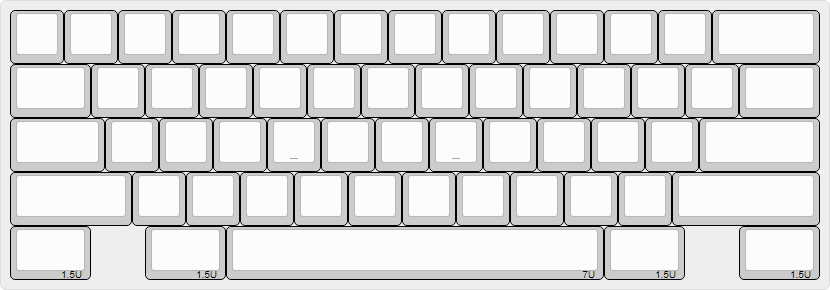
Main block with a winkeyless bottom row.
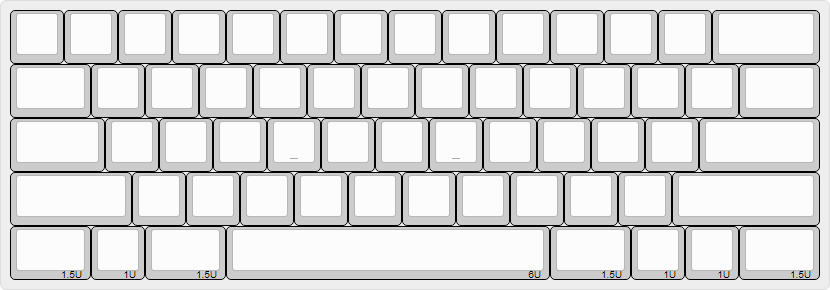
Main block with a non-standard bottom row.
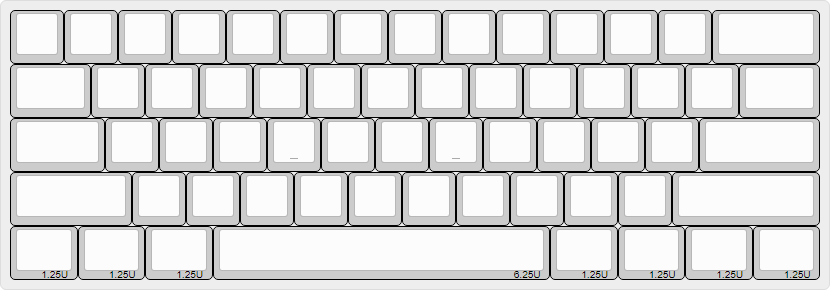
Main block with a modern bottom row.
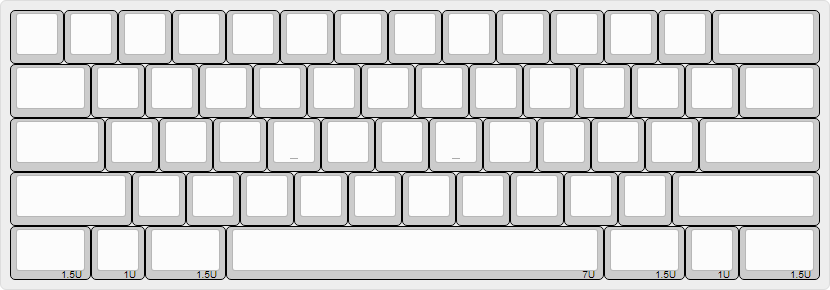
Main block with a tsangan bottom row.
Stepped/Non-stepped Caps Lock.
The leftmost key in the middle row of the main block of a keyboard (the one that typically gets
to be Caps Lock, but we haven’t gotten there yet) may be
stepped or
non-stepped. In prebuilt keyboards, this is generally a fixed
option per manufacturer (for example, all IBM Model M keyboards have a stepped key, while almost
all old Alps keyboards contain a non-stepped key instead); among enthusiasts, however, this is considered a
matter of personal preference. Manufacturers catering to this market (both of custom keyboards and of parts for them)
provide for both options.
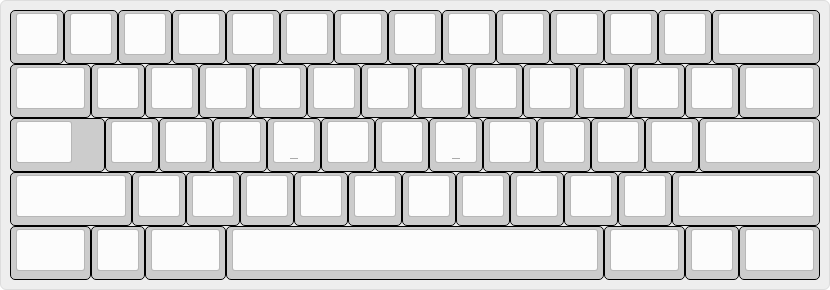
Main block with a stepped (Caps Lock) key.
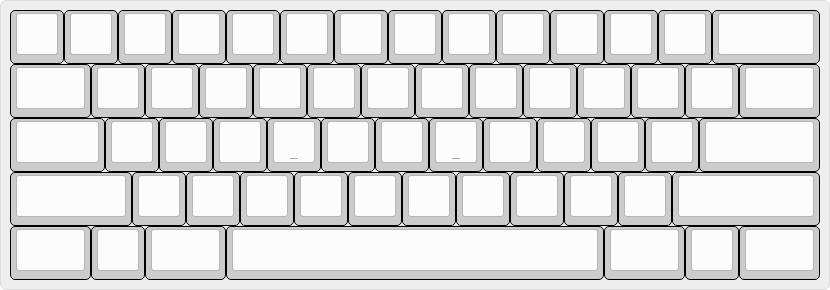
Main block with a non-stepped (Caps Lock) key.
ANSI and ISO... plus ANSISO and ISANSI.
In the left side of the fourth row of the main block of a keyboard there can either be a single key
(the one that gets to be Shift, but—again—we haven’t
gotten there yet), typically 2.25U in length... or there can be two keys, one 1.25U in length
(again, Shift) and a 1.0U key (which will
later will be assigned to be an alphanumeric key). The leftmost keys are generally referred to as “long
left Shift” and “short left Shift” respectively, while the extra key, if present, is referred to as
the “extra” or the “ISO alpha” key.
Independently, in the right side of the main block, there can be either a 1.5U key in the second row and a 2.25U
key in the third row OR a 1.0U key in the third row and a 2U tall key, 1.5U wide in the top half and
1.25U wide in the bottom half, covering the rest of the area; in both cases, the first key will later get to be the
backslash-pipe key and the second one will be made into Enter.
The latter keys, for the obvious reasons, get to be respectively called “horizontal Enter” and
“vertical Enter” (or, respectively, “ANSI Enter” and “ISO
Enter”).
Taken together, those two options give rise to four possible physical layout variants:
ANSI: long left Shift and horizontal Enter.
ISO: short left Shift and vertical Enter.
ANSISO: long left Shift and vertical Enter.
ISANSI: short left Shift and horizontal Enter.
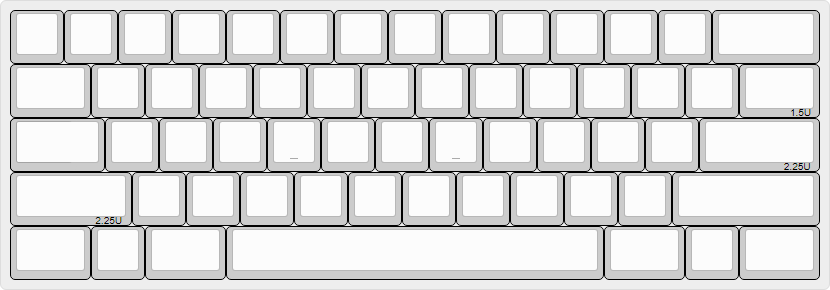
Main block, ANSI variant.
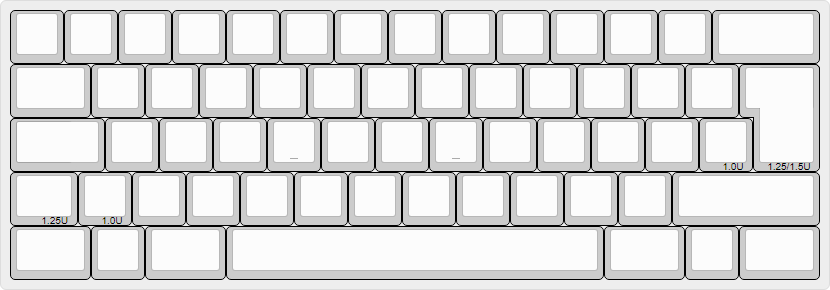
Main block, ISO variant.
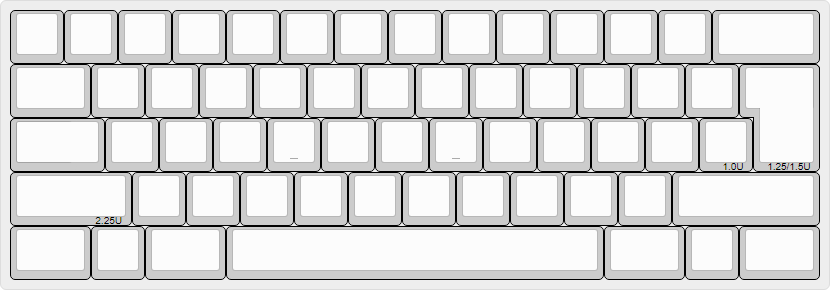
Main block, ANSISO variant.
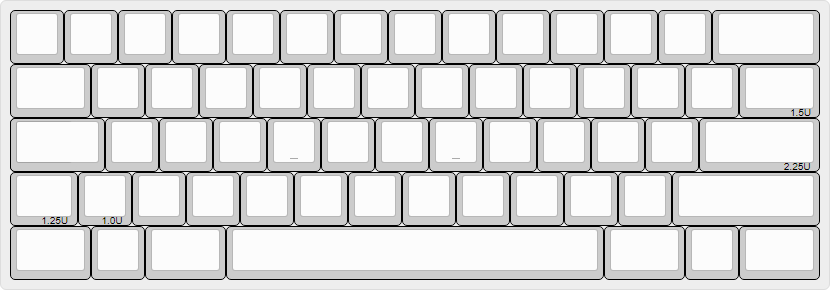
Main block, ISANSI variant.
The terms “ANSI” and “ISO” (and “ANSISO”
and “ISANSI” as well) refer to physical layout variants, not to form
factors (so an “ISO keyboard” may be anything from a battleship down to a
40%).
It must also be noted that the terms “ANSI” and “ISO” are improper in and of themselves:
“ANSI keyboards” are called that because they’re generally used in the United States of America and
“ISO keyboards” get that moniker because they dominate the European market (and other
continents as well!), but neither physical layout was created or even codified by either the American National
Standards Institute (ANSI) or the International Organization for Standardization (ISO). In fact...
Keyboards and their layouts evolved organically from the first typewriters through teletypes and terminals into
the keyboards of today. It was IBM (an American company) who codified and standardized what we
today call the “ANSI” and “ISO” variants into the Enhanced
Layout (and dumped the BAE Enter key, a monster of its own creation, but that’s another
problem).
Those terms have stuck because they’re convenient shorthands; it’s pointless to refrain from using
them, but the erroneous implication about the origin and territorial jurisdiction, so to speak, of each
physical layout variant does need to be avoided.
JIS
Due to the extra requirements the Japanese language has, keyboards used in Japan sport what is commonly called the
“JIS layout”. This physical layout variant looks superficially like an ANSISO keyboard (long left Shift
and vertical Enter), but contains further changes in the main block: the rightmost keys in the first and fourth rows
(the ones that will get to be Backspace and right
Shift later on) are split, adding a 1U key to their respective left sides
(those will serve later as extra alphanumeric keys), and the long bar is split into four
keys (three of which will be later made into modifier keys).
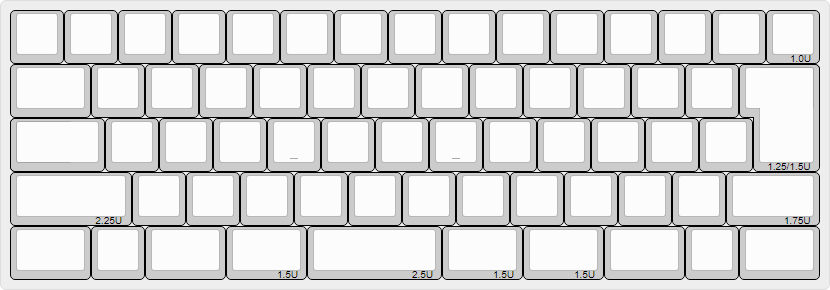
Main block, JIS variant.
(see an ANSISO main block instead)
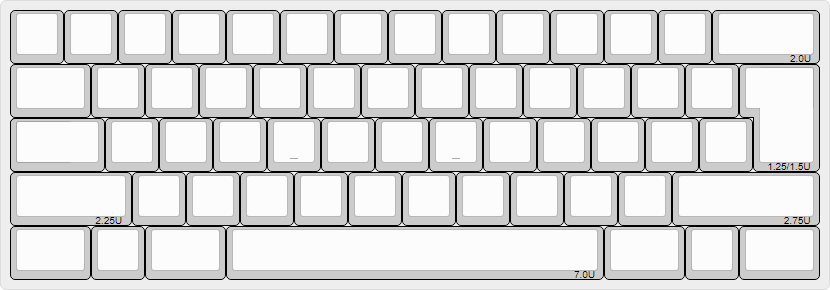
Main block, ANSISO variant.
(see a JIS main block instead)
Maddeningly, the bottom row of the main block in JIS keyboards is not standard! While the number of keys to be
present in it and (later on) their role in the logical layout is (mostly) agreed upon,
pretty much every manufacturer has its own ideas about the size each key should have, leading to plenty of
variations. The diagram above uses a tsangan-based bottom row for illustration purposes only.
ABNT
ABNT, the Brazilian body responsible for technical standards in that country, defined what is commonly called the
“ABNT layout”. This physical layout variant is the same as the ISO variant, with the only exception being
the rightmost key in the fourth row (the one that will get to be right
Shift later on) split on its left side to add an extra 1U key
(which will serve later as an extra alphanumeric key).
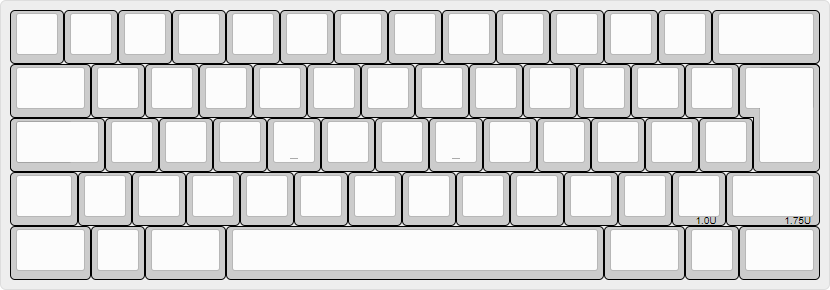
Main block, ABNT variant.
(see an ISO main block instead)
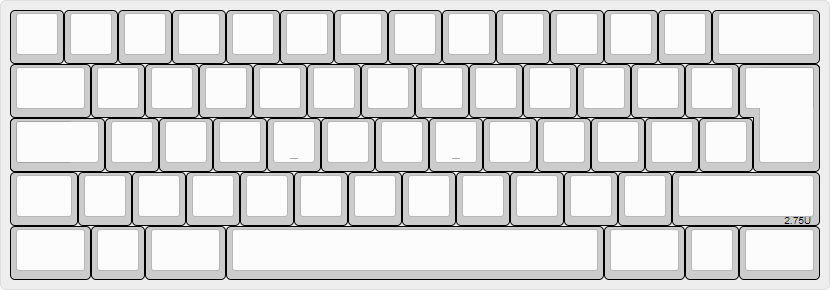
Main block, ISO variant.
(see an ABNT main block instead)
Although this looks weird to modern eyes, the addition of this extra key is actually pretty old, from the time
early keyboards added a column on the right side; most computer architectures kept the right
Shift key in its former (and current) position, while some moved it one unit to the right,
to add one more alphanumeric key; this variant died out after the mid-’80s, but by then the ABNT layout had
been standardized (and, tellingly, IBM made sure the Enhanced Keyboard would properly support
it, as well as the JIS layout).
To recap...
Let’s look again at that picture with four tenkeyless keyboards:

One form factor, four physical layouts.
- Top left: tenkeyless with ANSI, stepped Caps Lock and winkeyless bottom row.
- Top right: tenkeyless with ISO, non-stepped Caps Lock and modern bottom row.
- Bottom left: tenkeyless with ANSI, non-stepped Caps Lock and non-standard bottom row.
- Bottom right: tenkeyless with ISO, stepped Caps Lock and winkeyless bottom row.
Oh, yeah: and they’re all staggered.
Logical (or national) layout.
Form factor and physical layout deal directly with the
physical properties of a keyboard and therefore are strictly about hardware; on the other hand,
a logical layout defines what each key present in a keyboard
actually does when pressed: that, say, the fifth key in the third row of the main block will be
F, that the key in the top right corner of the same block will be
Backspace, that those keys in the righmost 4×5U key block will produce numbers and
arithmetic symbols (thus forming a “numeric keypad”), etcetera.
There are many, many different logical layouts. Most of the time, they are designed and built with the
requirements of a particular pairing of language(s) and country(-ies) in mind, and that is why the term
“national layout” is used much more frequently than the proper “logical layout” term.
With that said, given that national layouts tend to focus on languages, they will differ greatly on the placement
of special letters, typographical symbols (and to a lesser degree, plain letters and numbers) within what is widely
understood to be the alphanumeric (“alpha”) keys, while modifier keys, navigation keys and even the
numeric keypad will almost always coincide; there are few logical layouts where this baseline assignment
doesn’t hold:

Full-size ANSI keyboard with all non-alphas assignments.
(see an ISO keyboard instead)

Full-size ISO keyboard with all non-alphas assignments.
(see an ANSI keyboard instead)
This leads some to mistakenly believe that the assignment of modifier keys is part of the physical layout, while
in truth, it is not — it’s specially important to remember this when dealing with custom keyboards with a
compact form factor, where the assignment of navigation keys is a matter of personal preference.
So a logical layout is just software and not hardware?
Actually, it’s both.
It’s software, because the logical layout has been written into a program that is run by the computer, which
makes the keys pressed by the user produce specific actions.
Said programming actually works on two different levels: a program (typically run in the controller
chip of the keyboard itself) reads the (electrical) inputs produced by the user’s actions and sends scan
codes to the computer; the computer’s operating system receives those scan codes and translates them,
using a predefined table, into the actual characters (or whatever else) the user meant to type.
But it’s also hardware, because the assignments that a logical layout contains are printed on the
keycaps themselves, so the user will be able to see them.
Remember: when it comes to the logical layout, software and hardware do not need to coincide at all! The
computer relies entirely on its own inner programming and configuration and does not care about what may actually be
printed on the keycaps. This means that the user can get perfectly meaningful results from the
hostile keyboard pictured above, like this very paragraph that this author has typed on
that particular piece of hardware!
“ANSI national layouts”, “ISO national layouts”.
Again, a misnomer!
In general, logical layouts are designed with a particular form factor and a physical layout within it in mind;
for the specific arrangement of alphanumeric symbols for a given language, the latter is especially important. The
English (USA) national layout was designed
(or, more precisely, codified from extant practice) assuming it would be used with a long
left Shift, and with either a vertical or a horizontal Enter; because of this, both the ANSI and the ANSISO physical
layouts are a good fit.
On the other hand, the logical layouts for most European languages were outright designed with the ISO physical
layout in mind, mainly because the allure of a much needed additional alphanumeric key (between
the short left Shift and [what most of the time is] Z) was too strong to pass up;
not much tought, if any, was given to the possibility of using those logical layouts on ISANSI keyboards
(or, for that matter, in an entirely different form factor that would add even more keys to be
dedicated as “alphas”). The results vary; some, like the
German national layout, don’t really
suffer with such a change, but others, like the
Spanish (Latin America) supranational layout
are pretty uncomfortable to use on an ISANSI keyboard and are best served by an ISO keyboard (of
course, using either of those national layouts on an ANSISO or an ANSI keyboard is unfeasible). To wit:
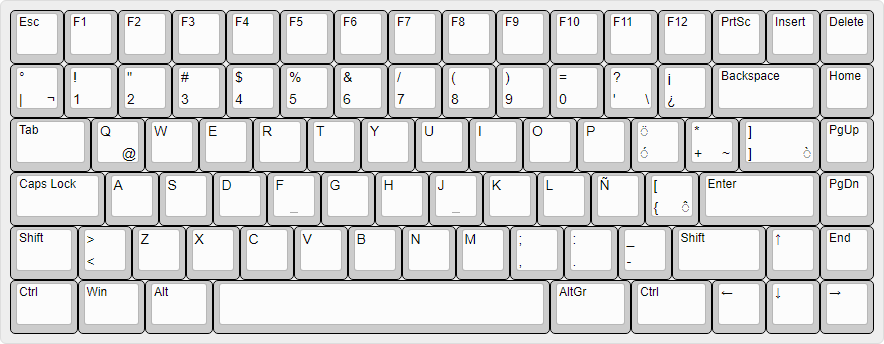
75% form factor, ISANSI physical layout, Spanish (Latin America) national layout.
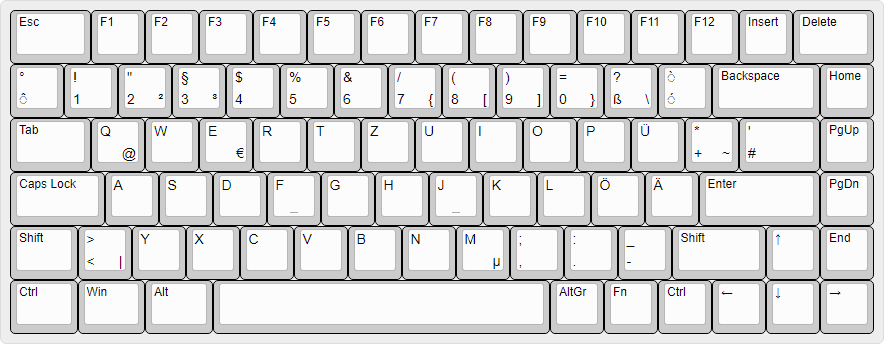
75% form factor, ISANSI physical layout, German national layout.
Note the hybrid bottom row in the first diagram, common in 75% keyboards. Note,
too, how in the second diagram the top and bottom rows follow the style of Vortex keyboards. Same form factor,
different physical layouts, different logical layouts... and not just for the differing languages.
So why is it a misnomer? Despite what may appear to be the case, given all of the above, a national layout
doesn’t actually need to be designed specifically for either the ANSI, ISO, ANSISO or ISANSI physical
layout variants; there are several logical layouts that are, indeed, designed well enough to be used with any of
those four.
Are those levels as separate as they seem to be described so far?
Of course not!
The three described layers of what a “keyboard layout” is are heavily interrelated: the features of
one influence the others and back. For example, that rightmost 4×5U key block in a full-size keyboard (that
this document doesn’t describe as a “numeric keypad” until reaching the logical layout
section) was thought up practically from the get-go as nothing other than a... numeric keypad
(which later was overloaded to be a mixed numeric/navigation keypad, but let’s not get into
that). The fact that the common numeric keypad’s 0,
+ and Enter keys are double-sized is because those
were the places where the number zero, the plus sign and the Enter command were located at in the first place, and
their estimated higher usage made it worth to enlarge the respective keys.
Last update: 31/10/2023.
Return to Keyboard-related resources.































































